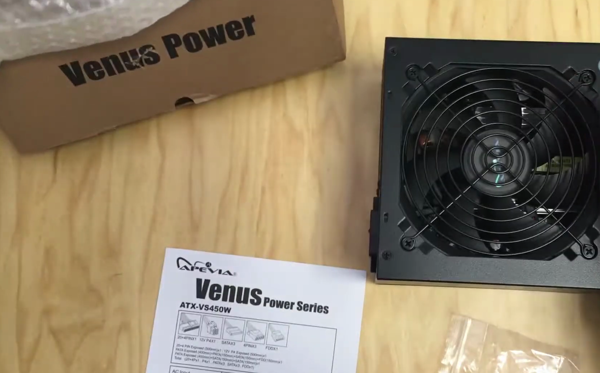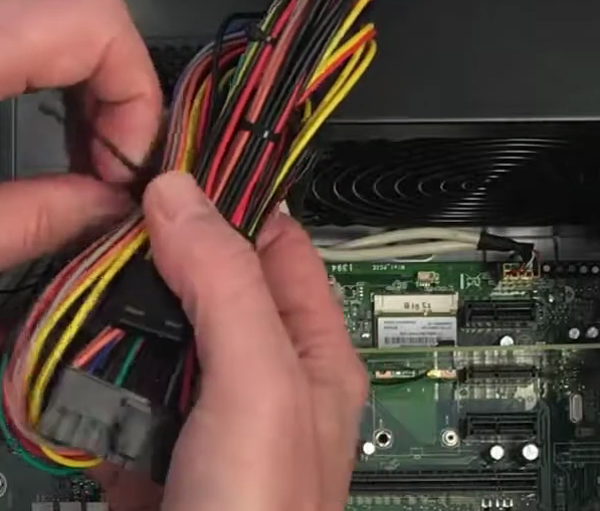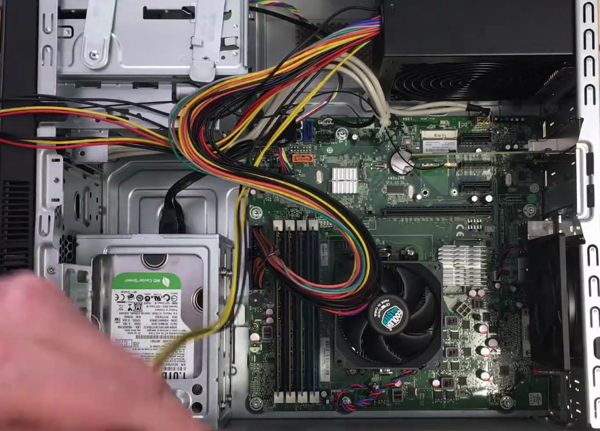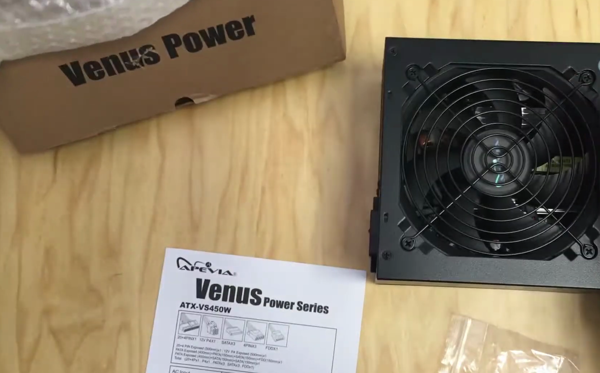Note: As an Amazon Associate I earn from qualifying purchases.
Review: Trying out the Apevia Spirit 600W ATX PSU (2024)
Introduction
I recently decided to give the Apevia Spirit 600W Power Supply a try for my mid-range PC build. I like its affordability and good performance for my computing needs (data engineering).
Specifications
| Property | Value | Property | Value |
|---|---|---|---|
| Model Name | spirit, spirit600w | Brand | Apevia |
| Compatible Devices | Personal Computer | Connector Type | ATX |
| Output Wattage | 600 Watts | Form Factor | ATX |
| Wattage | 600 watts | Cooling Method | Air |
| Item Dimensions LxWxH | 6.3 x 5.91 x 3.35 inches | Item Weight | 3.8 Pounds |
Photos
Click on photos to enlarge them:
Prices
Check prices of the Apevia 600W ATX Power Supply on:
Power and Performance

Navigating power supplies can be challenging due to performance versus cost considerations. The Apevia Spirit 600W Power Supply offers a decent balance. Here’s what I observed:
Pros:
For mid-range computer builds, this power supply provides adequate wattage.
Diverse array of connectors
Appealing aesthetics with black cabling
Operates quietly under light to medium workloads.
Budget-friendly price point
Cons:
A non-modular design may lead to complicated cable management.
The fan needs to operate quietly even during heavy usage.
Durability over time is uncertain
The power supply’s single 12V rail, suitable for most mid-range systems and providing stable power during testing, is accompanied by a variety of connectors. This ensures versatility for various components, allowing for the use of a 20/24 pin main power, multiple PCI, SATA, and peripheral ports, as well as a legacy floppy connector.
I appreciated the sleek black sandblasted casing and the mesh cover for the cabling. These features blend well with most builds and give the setup an expensive look, which is beneficial for those who prioritize aesthetics.
I also acknowledge the effectiveness of its thermal control. The 120mm black fan manages heat effectively, keeping noise levels low during usual operations. Although fan noise became noticeable under heavy loads or in warm conditions, this is a reasonable compromise given the cost.
Although the product includes heavy-duty protections, there have been unexpected power supply failures reported. While no product is perfect, reliability is essential. I haven’t experienced this issue personally, but it’s a concern worth considering.
Overall, the Apevia Spirit 600W power supply suits its target market. It offers sufficient power for a mid-range gaming or business PC at an affordable price. However, if you aim for high-end builds or require near-silent operation under heavy load, consider pricier alternatives. My experience with this power supply has been positive, and it represents good value for a casual setup with moderate energy requirements.
Connectivity and Versatility

The Apevia power supply, specifically the Spirit 600W model, showcases affordability without compromising connectivity and versatility. Notable features include:
1 x 20/24pin Main Power
1 x 4+4pin 12V
2 x PCI 6+2pin
4 x SATA
4 x Peripheral
1 x Floppy
I appreciate the flexibility afforded by the 8pin CPU connector that can be split into a 4+4 configuration for different motherboard requirements. Similarly, the 8pin PCI-E GPU connector adapts to a 6+2 arrangement, which is really handy for various graphics cards that I might use. Moreover, the 24pin motherboard connector that transitions to a 20+4 is an excellent example of the forward-thinking design that accommodates both older and newer motherboards.
While these features offer convenience, I’ve found some disadvantages. The fan, marketed as “auto-thermally controlled,” isn’t as quiet as claimed. This can be a concern for those creating PCs in noise-sensitive environments.
One of the challenges I faced was the cable length for the 4+4 pin CPU power. An extended length would have facilitated better cable organization, particularly in larger cases. Nevertheless, it was long enough for my mid-sized case and didn’t pose a major problem.
Despite these issues, I appreciate the PSU’s ability to support numerous devices. With four SATA connectors and several peripheral plugs, I didn’t need additional adapters or splitters for my devices. This is a significant advantage. Furthermore, safety features like Short-Circuit, Over-Current, Over-Voltage, Over-Power, Under-Voltage, and Over-Temperature Protections provide reassurance for the health of my system components.
While this power supply includes a mesh-style cover over the cables, I find it appealing for its cleaner appearance inside the case. The black color scheme also helps maintain a neat aesthetic that I prefer.
To sum up, the Apevia Spirit 600W is a good power supply for basic to mid-level PC builds due to its range of connectivity options. While it could improve in areas like cable length and noise, these issues are minor compared to its versatility and affordability. It’s a solid recommendation, especially for those building on a budget.
Design and Build Quality

When evaluating the design and build quality of the Apevia Spirit 600W Power Supply, I’ve noticed several notable features during my usage. The power supply boasts a black sandblasted casing that blends well with most PC builds due to its subtle and tidy appearance. Furthermore, the cable management is manageable, even though it isn’t modular – the cables are equipped with a mesh cover, contributing to an organized and harmonious internal layout of my build.
Here’s a description of the design features:
Black sandblasted casing offers a sleek, neutral design.
Non-modular cables with mesh style covering minimize visual clutter.
A 120mm black fan is provided for cooling.
However, the Spirit 600W power supply has some weaknesses. Although it claims heavy-duty protections, its connectors can feel delicate and fragile. I haven’t experienced any breakage yet, but there’s a concern about future problems, particularly during installation when bending and maneuvering are necessary.
The power supply is equipped with an auto-thermally controlled 120mm fan to regulate temperature. However, the fan’s operation is not as silent as advertised, which might pose a concern for those who are particularly sensitive to noise.
The Apevia Spirit power supply is not only robust but also well-crafted. This well-built component compares favorably to other power supplies within its price range. The carbon-fiber style wraps further enhance its appearance, making it an alluring customization project for some users.
As for the cooling method, which is an air-based system, it performs adequately. It may not have the nuanced operability of more expensive units, but in my gaming rig, it’s been working without causing any overheating issues, signaling a competent design sensibility.
The Apevia Spirit 600W Power Supply is a practically designed and solidly built power supply that doesn’t break the bank but still manages to look more expensive than its actual cost. Despite its budget-friendly price, it offers functional design elements without sacrificing performance or appearance. Its cables do not appear cheap, contributing significantly to its sophisticated look and feel. This power supply is a practical investment for budget-conscious builders or those setting up secondary systems who desire a visually appealing and high-performing component. Overall, this power supply gets the job done effectively and efficiently, making it an impressive and commendable choice at its reasonable price point.
Overall Value and Conclusion

When evaluating the worth of the Apevia Spirit 600W Power Supply, the advantages outweigh the drawbacks. Here’s a concise summary:
Pros:
Cost-effective solution: Suitable for those with limited budgets.
Ample cables are provided for different components with 8-pin connectors.
Split connectors offer flexibility for use with various hardware, old and new alike.
The fan produces little noise, barely noticeable above the case fans.
The design is unobtrusive with black cables that blend well.
Cons:
The fan might be noisier than anticipated by some users.
Connector durability and cable length have raised concerns.
The connection is somewhat unreliable and efficiency could be improved.
I appreciate the installation process being straightforward and uncomplicated. The motherboard connector matching was important, but easier due to the splitting feature of the 8-pin connectors. The all-black cables with mesh covering in this PSU are a design choice I value, as I’ve seen colorful ones spoil the look.
My experience with my system, which includes old and new parts, has been different from some users who have reported loud fan noises or cable issues. The power supply unit fan in my setup has operated quietly, and I have been able to manage the cables without major difficulties.
As with any budget-friendly product, there are risks. I was hesitant at first due to conflicting feedback about its durability and performance. However, after several months of use, my unit has run smoothly without issues, accommodating a GTX 1070 and various other PC components.
However, not all users encountered trouble-free experiences. Some reported early failures, and one incident resulted in a significant explosion. Fortunately, the protective measures seemed effective in shielding other computer components from harm.
As a final thought, the Apevia Spirit 600W Power Supply doesn’t have advanced features of expensive models but exceeded my expectations for its price range. It doesn’t offer modular cabling, high efficiency ratings, or superior build quality. However, it functions reliably for daily computing tasks. Budget builders or those seeking a low-cost solution should consider this power supply, but keep in mind its limitations and anticipate upgrading to a more expensive one later for intensive gaming or heavy computer usage.


